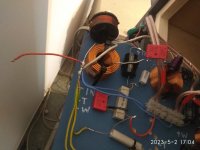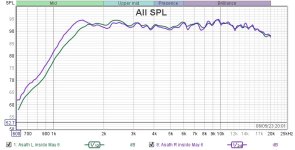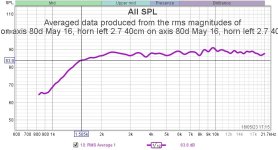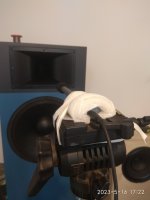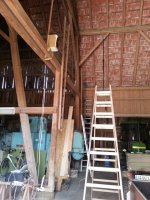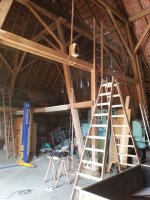I just placed an order at Quint store for crossover parts suitable for the Lavoce horn driver.
In the meantime i have replaced crossover parts with what i have on hand.
Then i took two Horn near field measurements,one with the New parts and another with the old values.
Green is the graph with the values close to suitable that i have on hand(see second picture)
Red graph is with the wrong crossover values(that's for Tymphany Horn).
Smoothing 1/24.
In the meantime i have replaced crossover parts with what i have on hand.
Then i took two Horn near field measurements,one with the New parts and another with the old values.
Green is the graph with the values close to suitable that i have on hand(see second picture)
Red graph is with the wrong crossover values(that's for Tymphany Horn).
Smoothing 1/24.
Attachments
Last edited:
Due to a mistake, at least, i have my first experience with REW. in speaker measurements.
Last edited:
I couldn't resist to modify my second speaker using what i had on hand.
Then i measured again for comparison.
Right speaker crossover(2nd picture) is even more out of specs.No suitable coils.
Mic is in the center of horn,woffer disconnected
Then i measured again for comparison.
Right speaker crossover(2nd picture) is even more out of specs.No suitable coils.
Mic is in the center of horn,woffer disconnected
Attachments
Last edited:
Neither in the Right not in the Left crossover uses the recommend value components in horn filter.
I have order the right values parts for the Lavoce horn driver but in the meantime i had the curiosity to see what i can do using what i have on hand.I used coils with different inductance and resistance
in horn filter.
Even so, the result is very good, especially for the left speaker whose coils are closer to those recommended by the designer.
I have order the right values parts for the Lavoce horn driver but in the meantime i had the curiosity to see what i can do using what i have on hand.I used coils with different inductance and resistance
in horn filter.
Even so, the result is very good, especially for the left speaker whose coils are closer to those recommended by the designer.
Last edited:
"Even so, the result is very good, especially for the left speaker whose coils are closer to those recommended by the designer."
Don´t´ be too sure about that. Since this (flattest) is the cross over point, you could never be sure, and the right might end up
being the one making the most even transition from bass to horn, when measured from the listening position. 😉
Don´t´ be too sure about that. Since this (flattest) is the cross over point, you could never be sure, and the right might end up
being the one making the most even transition from bass to horn, when measured from the listening position. 😉
What happened here? Is something wrong with me? Appreciate anything that may or may not help me and others. Please note that English is not my first language. I am very sorry if I said something inappropriate,🙏
That might be so..... and if so, I apologize. You may also be right and me be wrong according to left/right. 😉 That remains to be seen, when you make a measurement of the whole speaker system. Too late to modify my post now, but please explain what you meant with this:
Oh cold again?😞 (dissapointed face)
I just now learn about REW measurements.
Nothing wrong with you.
I was hoping this last graph was something good. I didn't quite understand the meaning of your post and was disappointed for the bad measurements.
Re-reading your message, I understand that the measurements are considered good. However, you have a different opinion on which of the two channels is better.
In any case i appreciate your effort.🙂
Nothing wrong with you.
I was hoping this last graph was something good. I didn't quite understand the meaning of your post and was disappointed for the bad measurements.
Re-reading your message, I understand that the measurements are considered good. However, you have a different opinion on which of the two channels is better.
In any case i appreciate your effort.🙂
Thanks @thimios ...... All probably just a misunderstanding.
We may have a difference of opinion.... That´s fine.
What I was trying to suggest was, that the curve with a little "lift" in the bottom end might be reason for "no dip" at the crossover point,
when measuring the complete response from your listening position. Will of course depend on the accuracy of crossover components
involved 👍
We may have a difference of opinion.... That´s fine.
What I was trying to suggest was, that the curve with a little "lift" in the bottom end might be reason for "no dip" at the crossover point,
when measuring the complete response from your listening position. Will of course depend on the accuracy of crossover components
involved 👍
Asathor,the horn driver connected only.
The distance from horn center is 1.5m from the floor & 2m from the ceiling.
Umik1 placed at a vary positions from 15 to 80cm distance, in and 15 degree off axis.Umik1 at a high of 1.5m.
SPL level always the same 80db uncalibrated
Crossover corrected with the Lavose recommented parts.
The distance from horn center is 1.5m from the floor & 2m from the ceiling.
Umik1 placed at a vary positions from 15 to 80cm distance, in and 15 degree off axis.Umik1 at a high of 1.5m.
SPL level always the same 80db uncalibrated
Crossover corrected with the Lavose recommented parts.
Attachments
Last edited:
I unfortunately don't have a measurement of the tweeter with crossover saved, but what you measured looks very good.
What is not so nice is the mount of your microphone. Due to the large head of the stand, there are significant reflections there, which add up in all measurements.
I know, to measure once every few months you don't want to spend a lot of money unnecessarily, but simple microphone stands with cantilevers are also available for little money. For example:
https://www.thomann.de/de/km_27105.htm
You can also find them quite often used.
What is not so nice is the mount of your microphone. Due to the large head of the stand, there are significant reflections there, which add up in all measurements.
I know, to measure once every few months you don't want to spend a lot of money unnecessarily, but simple microphone stands with cantilevers are also available for little money. For example:
https://www.thomann.de/de/km_27105.htm
You can also find them quite often used.
Thanks,i have one on order already.
As soon as i will have this received,i will try an outdoor measurement.,🙂
As soon as i will have this received,i will try an outdoor measurement.,🙂
outdoor is not really necessary, this only brings advantages if you can place the measurement setup very high. And even then, you can't capture the entire bass range without interference. I once measured in my buddy's barn a few years ago, at a height of 3.5 meters. Even there, the measurement was only clean down to about 60Hz.
Attachments
I can't do this!
I haven't this oportunity.
Then the only remain is the indoor psevdo anechoic methode.
I have to study the way.
I haven't this oportunity.
Then the only remain is the indoor psevdo anechoic methode.
I have to study the way.
For 2-way with a crossover frequency above about 1kHz, indoor measurements are perfectly sufficient. You just have to set the right time window.
Everything that happens below 300Hz can be perfectly simulated with the TSP.
If you want to know exactly, you can also add a near-field measurement from the woofer, but as I said, that's not really necessary.
Everything that happens below 300Hz can be perfectly simulated with the TSP.
If you want to know exactly, you can also add a near-field measurement from the woofer, but as I said, that's not really necessary.
- Home
- Loudspeakers
- Multi-Way
- Asathor - a JBL 4367 Clone

